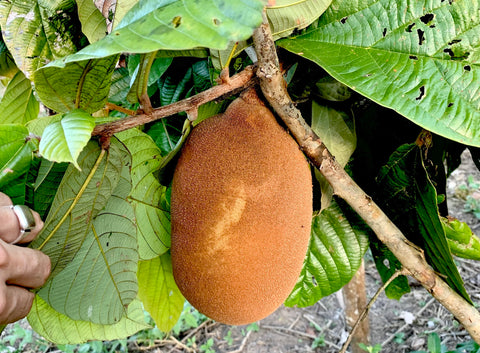Theobroma bicolor is a plant cousin of cocoa that appeals to lovers of exotic flavors. It is also known by many names such as "cacao blanco", mocambo (majambo), or even pataxte. This species of Theobroma (same genetic family as cocoa) and c upuaçu is native to South America and looks exactly like cocoa in its fruit (or pod, round and furrowed with hollow veins) and are foliage with a more rustic appearance.
A plant which has been present in the local cultures of its regions of origin where it is difficult to differentiate from cocoa. In Europe, this plant is still little known and is not exported outside the South American continent.
 |
 |
 |
Theobroma bicolor, Theobroma grandiflora and Theobroma cacao L.
In this article, we will explore both the taste and botanical aspects of Theobroma bicolor, allowing you to delve into the world of this tropical wonder.
Theobroma bicolor, a botanical nugget
Theobroma bicolor belongs to the Malvaceae family and is closely related to the cocoa tree, Theobroma cacao. It grows naturally in the Orinoco and Amazon basins at low altitudes, notably in Colombia, Peru and Ecuador. To recognize it in the forest, here are some key botanical characteristics of this plant:

Fruit and foliage of Majambo photo by Racine Carrée
- The tree: The bicolor is a medium-sized tree that can reach 15 meters in height. Its leaves are large and oval, bright green. it is considered an understory tree that requires the shade of the forest canopy to thrive.
- The flower: The flowers of cocoa blanco are small, white to pale yellow and are cauliflorous, forming directly on the trunk of the tree, which is a distinct characteristic of theobroma.
- Fruit: The fruit of Theobroma bicolor is oval-shaped and can measure 15 to 30 cm long. Its skin is rough, green in color, and contains a rich, soft and creamy white pulp. Inside there are many seeds, which can be used

An exquisite taste discovery
Theobroma bicolor is especially appreciated for its seeds and pulp, which are consumed in different ways and offer an exceptional taste experience:
- Flavor: Cacao blanco seeds have a sweet, creamy, slightly tart flavor, which distinguishes them from common cocoa which is more bitter and requires fermentation. The pulp surrounding the seeds is also consumed for its sweet taste in juice or molasses.
- Culinary uses: Theobroma bicolor seeds are often used to prepare hot drinks, powders or sometimes chocolate. The pulp is sometimes used to make juices or tropical desserts.
- Traditional Drinks: In areas where cacao blanco is grown, it is often made into a drink called "chuculat," which is prepared by mixing the seeds with water, sugar and spices.
- Nutritional Value: Theobroma bicolor seeds are rich in essential nutrients, including vitamins, minerals and antioxidants, making them a healthy and delicious snack. They are also rich in omega 9 and contain caffeine.
- Vegetable milk: Crushed, then powdered, they are an excellent alternative to classic milk and bring sweetness to the mixture, perfect for lactose intolerants and vegans.
Theobroma bicolor, or cocoa blanco, is a tropical plant with unique botanical characteristics and exquisite flavor. By combining a distinctive appearance with a sweet, creamy flavor, this species has conquered palates around the world. In addition to its taste value, cacao blanco holds significant cultural importance to indigenous communities in South America. It is a perfect example of the rich plant biodiversity and diversity of flavors that our planet has to offer.
The two-tone and the Bean-to-Bar movement
Bean-to-Bar artisan chocolatiers are always looking for new flavors to perfect their creations. By turning to majambo, they explore a natural and harmonious alliance with cocoa. We tested the tablets which explored this happy combination:
Square Root, 60% vegetable milk
In this recipe, majambo is crushed and used instead of milk, giving this tablet a decidedly vegetable nuance. With its sweetness and aromas evoking fresh almonds, this chocolate has the texture of a Dark Milk but with a softer and more savory appearance revealed by the majambo.
Majambo milk 60% by square root
Qantu, Hidden Treasure 80%

Qantu, Hidden Treasure and Majambo Milk 60% by Square Root
Small addition from Nicolas in his last article " Theobroma bicolor and grandiflorum: can we make chocolate from it? " tells us about the crossing of theobroma cacao and Theobroma bicolor for unique chocolates
“The proximity of the fruits of different theobroma also allows us to experiment with other approaches, such as the hybridization of cocoa trees with their cousins. These crosses are probably at the origin of the wild beans used, for example, by Qantu to produce its incredible Hidden treasure Another possibility is to mix cocoa beans with those of other theobroma. A solution also explored by Barbon, the result of which I will share with you soon.
If you wish to continue your research on majambo, we recommend the sites and articles:
Potential of the amazonian exotic fruit for biorefineries: The Theobroma bicolor (Makambo) case



Comments